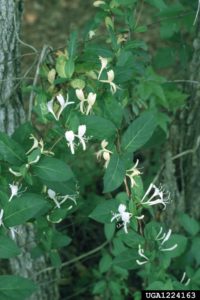
Have you enjoyed the sweet smell of Chinese privet blooms or the loved the privacy provided by Callery pear trees? Have you wondered why so many plant enthusiasts hate them? Sometimes it is hard to see beyond our own backyards to the ecological and financial harm afforded by privets, kudzu, mimosas, English ivy, Callery pears and Japanese honeysuckle, to name a very few of the many invasive species found in our area. Many plants used in our personal gardens and bought from local sources can readily spread so it is imperative to research plants and have an awareness of their propensity to spread invasively so we can avoid introducing them to our home landscapes.
Invasive plants refer to any species that is not native to an ecosystem AND whose introduction does or is likely to cause economic or environmental harm or even harm to animal or human health. Plants may cause harm by choking out the native plant growth in an area. They often develop quickly, free from natural predators in their new environment, and out compete and displace native species, leading to a reduction in wildlife food and habitat. Invasives can also decrease property values (think of lots overrun with kudzu or privet) causing a financial burden along with great sweat equity to those trying to bring the plants under control. Timber forests can be severely impacted when invasives grow rampantly. It is important to note that a plant being a nonnative does not automatically mean it is a harmful plant in the home landscape—only if it is nonnative and causes harm in any of the ways mentioned earlier.
In addition to being concerned, we also should take some steps. First, we need to educate ourselves to have an awareness of which plants are invasive. When we receive plants from those well-meaning friends who love to share, take a minute to question the name of the species and its growth habits. Purchase plants from reputable nurseries who have a knowledgeable staff to guide you in proper plant selection. If you love the look of English ivy or nonnative wisteria, ask for recommendations of similar plants which are more easily controlled. Many organizations and programs at local, state and national levels provide helpful information to educate citizens on how to identify, prevent, control and eradicate invasive species. Helpful resources include the following: Georgia Invasives Species Task Force (https://www.gainvasives.org/), Center For Invasive Species and Ecosystem Health(http://www/bugwood.org/), and Georgia Exotic Pest Plant Council (https://www.gaeppc.org/). In addition, EDDMapS is a web-based mapping tool used to document in real time invasive species across the nation. Volunteers provide data via a smartphone app or web-based data entry. Information is available at https://www.eddmaps.org/.
While prevention is definitely the easiest route, often times we already have a host of invasives scattered throughout our landscapes by the time we realize this is a problem. With cooler fall temperatures here, maybe you can commit to clearing invasives from your property a section at a time. After educating yourself on typical invasives, identify which you have and consult with your local extension office on best practices for getting rid of them. By stopping the spread on your property, you will more than likely be helping your surrounding neighbors as well. Eradicating problem plants is not an easy task nor a necessarily quick one, but it is a worthwhile endeavor.
The author of this article, Molly Zablan, is a Paulding UGA Extension Master Gardener Extension Volunteer. For more information contact Paulding County UGA Extension at 770-443-7616 or view our online resources at www.ugaextension.org/paulding.